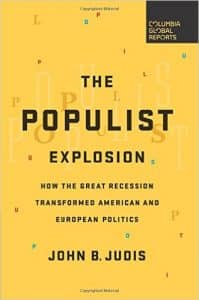Parties Struggle with ‘Populist’ Uprising
The presidential election of 2016 signaled, by almost all accounts, a “populist” uprising. But what, exactly, does populism mean, in this country and in Europe where similar challenges to political elites are taking place?
In The Populist Explosion: How the Great Recession Transformed American and European Politics, John B. Judis offers what Thomas Edsall of The New York Times calls “far and away the most incisive examination of the central development in contemporary politics.” Judis is also the author of, among other books, The Paradox of American Democracy: Elites, Special Interests, and the Betrayal of Public Trust.
What we witnessed in November was to many observers a surprising level of anti-establishment sentiment on the right, including the “alt-right.” But you say populism for most of the American past has been associated with the left. Is that correct?
Historically, yes. Going back to the People’s Party of the late 19th century through Huey Long and all the way to Occupy Wall Street and support for Bernie Sanders, populism has been a movement of the left. But with George Wallace, although he was a Democrat, we saw a rise of right-wing populism. By the way, I use the term populism simply to describe an impulse, not as a derogatory term.
You also write that populism of the right or the left is not a “program” or a set of political convictions. Then what is it?
Populism is what one political scientist calls a “logic” or a “language.” It refers to a relationship between “the people” and “the establishment.” Of course, how “the people” and “the establishment” are defined makes a big difference. Those terms can refer to different things. And the meanings can change. The “people” can mean the poor, or it can mean the struggling middle class. The establishment can mean Wall Street or the leadership in Washington. When the tea party first came to public attention, the “establishment” was Democrats. Now it seems to be the Republican leadership in Congress.
That might be one reason it is difficult to define populism with any specificity.
What differences do you see between American populism as it is manifesting itself today and the European version?
The differences are significant, and they have to do with our party systems. In America, we have a two-party system, whereas in Europe there tend to be multiparty systems. In this country, our populist movements are identified with an individual. But in Europe, populism manifests itself in parties. There’s not really a European equivalent to Ross Perot or Donald Trump, unless you stretch it a bit and count the Le Pen family in France. In America, one of the main parties usually absorbs the populist group and its concerns, as the Republican Party absorbed the tea party.
You make another distinction, based on attitudes toward foreign policy.
That’s right, and this distinction is important when people want to see similarities between European fascism and the kind of populism we’ve just witnessed. German and Italian fascism of the 1920s was expressly expansionist. They wanted to conquer militarily. American and European populism today are narrowly nationalistic. By that I mean, they are turning away from supra-nationalist institutions, which is what the Brexit vote reflects. Trump doesn’t want to annex Mexico. He wants to keep Mexicans out. His economic policy is nationalistic. He regards our international trade agreements with great skepticism, because he thinks they have resulted in loss of manufacturing jobs here at home.
 You argue that a populist explosion is a sign that the establishment is not doing something right, and how the establishment responds will determine its own future health.
You argue that a populist explosion is a sign that the establishment is not doing something right, and how the establishment responds will determine its own future health.
I think that’s true, and the question now is how the Democrats respond to their defeat. So far, they haven’t responded well.
In what sense?
The question is whether they will learn from their defeat. While I believe it is true that Hillary Clinton was meaning only some Trump supporters when she referred to “deplorables,” this did reflect what I think was a deeper dismissal of working-class voters. The Democrats used to be the party of “the common man,” but episodes like this lend support to the charge that it is the party of minorities and the upper middle class. This tension in the party goes back to 1968 and the Wallace candidacy, when he split with the Democrats to run on the American Independent Party ticket. It is also reflected in later party divisions over “Reagan Democrats.”
How will the Democrats respond?
A lot depends on what Trump does. If he tries to privatize Medicare, for example, he hands the Democrats a great basis for reviving the party’s prospects. But if they continue to tell themselves and others that Trump’s victory was all based on an appeal to racism, that might make them feel good, but it doesn’t signal a way for the party to move forward. So far, I think they’re doing everything wrong.
How so?
If you went to Trump rallies, you’d notice that he spent a lot of the time talking about trade and runaway jobs — about economics and trade. Then he’d throw in some zinger about a beauty pageant winner’s weight or something like that, and all the national media covered was the zinger. This coverage made it possible to miss the extent to which his campaign was based on trade and economic issues. Trump’s popularity was based on this appeal to economic concerns, and Democrats need to understand this fact and respond to it if they want to bounce back.
Reach Judis at [email protected] or 301.933.9027.


